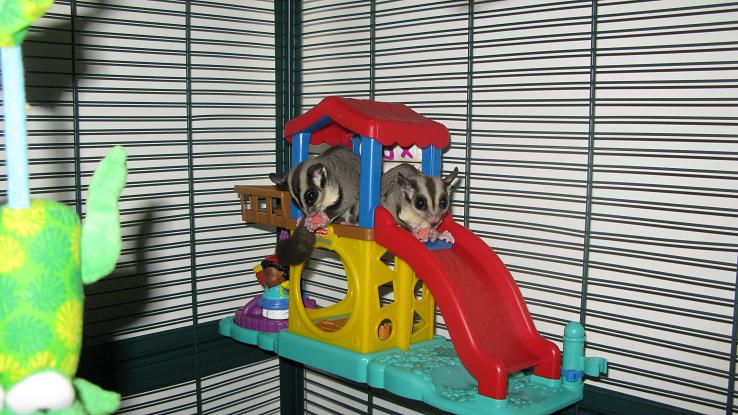Sugar gliders require quite a bit of space. Although they
are small animals and don’t take up much room during the day, they need room to
glide at night.
Size
The minimum requirement for a cage for 1-2 gliders is 3' x 3’ x 2’. The larger your colony, the bigger your cage needs to be. The general sizing is 5 cubic feet per additional glider. However, the bigger, the better!
Bars
The bars of the cage cannot be any wider than ½” apart—if
they can get their head through the bars, they can get their bodies.
When buying a cage, it is also important to find out what
the bars are coated with. Gliders are chewers and will get any paint or
coatings off. Look for safe 'powder coat' high quality finishes—not PVC coated
cages.
Gliders are very playful! Make sure that you give them
plenty of toys, hammocks, pouches and things to climb on. They are natural foragers,
so make sure that you give them toys that make them work a little bit. For
example, some glider owners put treats in cups or plastic Easter eggs so that
their gliders have to search for their food.
Wheels
Finally, gliders also love to run on wheels. Make sure
that you are getting a wheel that they can’t get their feet stuck on or their
tails wrapped around the supporting beam. That means NO wire tracks or middle supporting beam that is stationary. Wheels should be ~12 inches in diameter.
The best wheels are Stealth Wheels in my opinion. They are a bit more expensive, but very, very quiet. We use to keep our gliders in our bedroom and you can't hear them running at all. There are several wheels coming out that are in the same style and under a different name. Those would be just as good :)
Another favorite is Fast Tracks. These are hand made in a pet free and smoke free area. They are very similar to Stealth Wheels but a bit cheaper and a few more options.
Another favorite is Fast Tracks. These are hand made in a pet free and smoke free area. They are very similar to Stealth Wheels but a bit cheaper and a few more options.
A new favorite is the Raptor Wheel. They are just like the Stealth and Fast Tracks.
Some people will also use Treadmills. They are flat discs with fabric over top for traction. I have personally never used one.
Comfort Wheels were previously thought to be safe, but knew evidence is coming out that they are not a good choice. The three main complaints are that they can get their toes stuck in the little slits where the two colors meet, the back axle (which is exposed) can grab tails if a glider happens to be behind the wheel while another one in it, and finally, the two pieces have been known to completely pop apart while the gliders are using it. As you can imagine, that would be very scary!
Wodent Wheels use to be considered sugar glider safe, however after time we are finding that they are not. Gliders can actually break their necks trying to get into the wheel if another glider is already in it. The front of the wheel is solid with four little openings for the gliders to go in and out. They can also skin the tails. The tail can get pinned between the guard and the wheel front or back causing break or degloving. Finally, you will notice that gliders like to jump while running--this can cause issues with the center beam that can result in death.
Wodent Wheels use to be considered sugar glider safe, however after time we are finding that they are not. Gliders can actually break their necks trying to get into the wheel if another glider is already in it. The front of the wheel is solid with four little openings for the gliders to go in and out. They can also skin the tails. The tail can get pinned between the guard and the wheel front or back causing break or degloving. Finally, you will notice that gliders like to jump while running--this can cause issues with the center beam that can result in death.
Pouches
Sugar gliders are marsupials, so they require pouches to sleep in. The best are double lined polar fleece. You need to make sure that there are no exposed seams that they could get their nails caught in. Sugar gliders cannot be potty trained, so they will soil their pouches often. Make sure you have several on hand!
You can either make or buy your bedding!
They are also arboreal. That means they can live their entire lives never leaving trees in the wild. They need things to climb on.
Here are some great examples of bedding and toys!

No comments:
Post a Comment